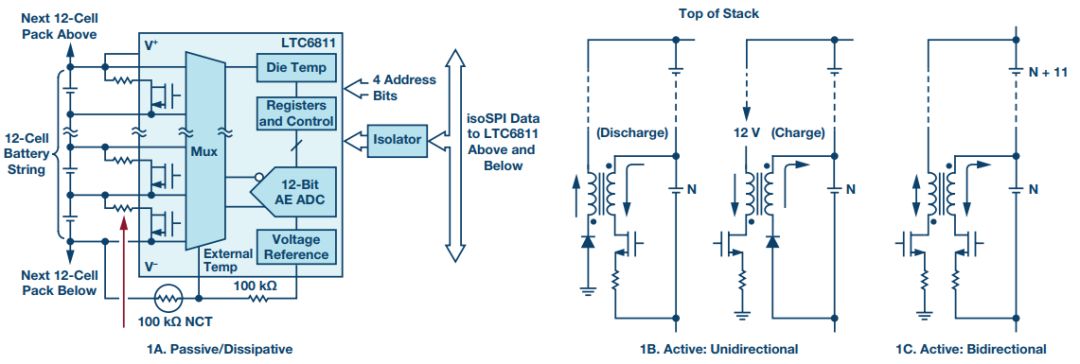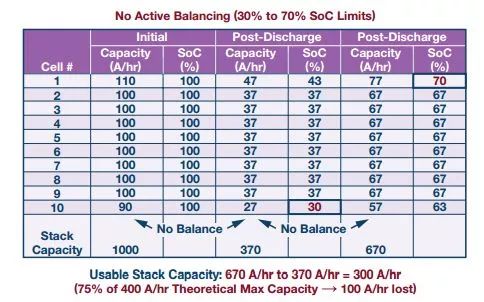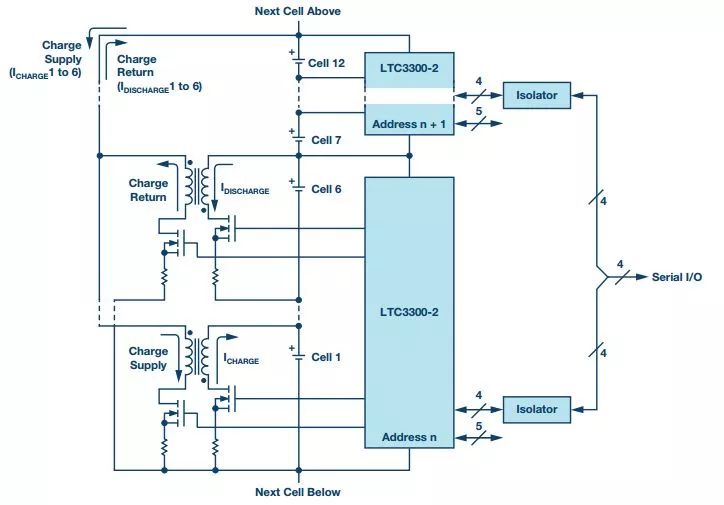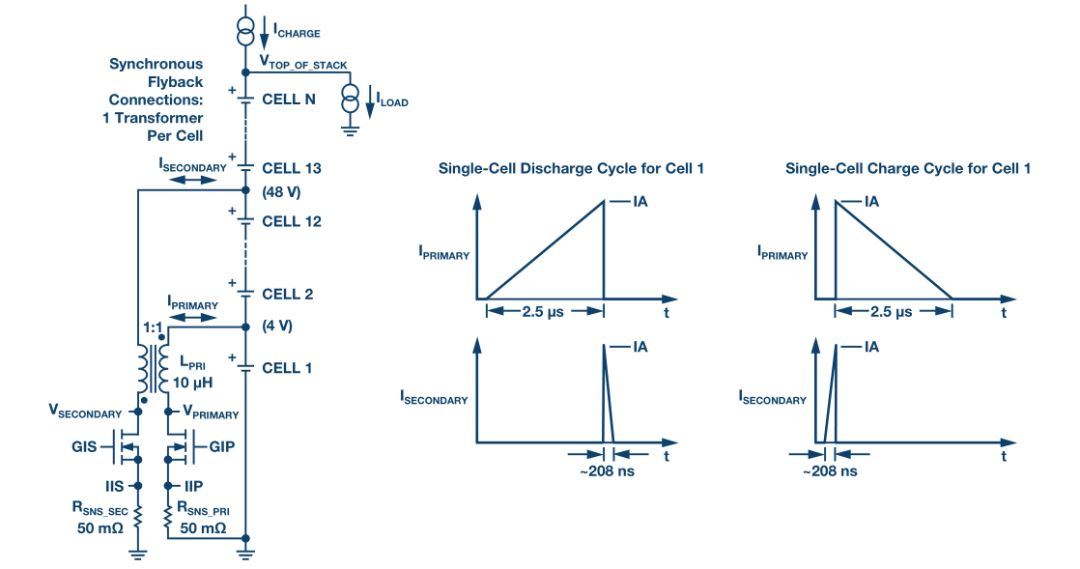Large battery pack consisting of lithium polymer or lithium iron phosphate (LiFePO4) battery cells connected in series, high energy density, high peak power, widely used in pure electric vehicles (EV or BEV), hybrid electric vehicles (HEV) ), plug-in hybrid vehicle (PHEV) to energy storage system (ESS) electric vehicle market. Despite the growing demand for high-capacity battery cells, battery prices are still quite high. The problem is that even higher-cost, higher-quality battery cells age and do not match after repeated use.
There are two ways to increase the capacity of a battery pack with a mismatched battery unit:
One is to use a larger battery from the beginning, but the cost performance is not high;
One is to use active equalization, a new technology that restores battery capacity in the battery pack and boosts power quickly.
Fully connected battery cells, need to be balanced
When each battery cell in the battery pack has the same state of charge (SoC), we say that the battery cells in the battery pack are balanced. SoC refers to the ratio of the current remaining capacity of a single battery to its maximum capacity when the battery is charged and discharged.
For example, if a 10 amp battery unit has a remaining capacity of 5 amps, its SoC is 50%. All battery cells must be kept within a certain SoC range to avoid damage to the battery or shorten life. The allowable minimum and maximum values ​​of the SoC vary from application to application. In applications where battery runtime is critical, all cells can operate between a minimum SoC of 20% and a maximum SoC (or fully charged state) of 100%. Applications that require the longest battery life may limit the SoC range from a minimum of 30% to a maximum of 70%. These are typical SoC limitations for electric vehicles and grid storage systems that use very large and expensive batteries and are extremely costly to replace. The primary role of the Battery Management System (BMS) is to closely monitor all cells in the battery pack to ensure that no battery cells are charged or discharged beyond the minimum and maximum SoC limits of the application.
For series/parallel battery cell arrays, it can generally be considered that the battery cells connected in parallel are automatically equalized with each other. That is to say, as time passes, as long as there is a conductive path between the battery cell terminals, the state of charge between the battery cells connected in parallel is automatically equalized. It can also be considered that the state of charge of the battery cells connected in series may vary over time for a number of reasons. Temperature gradients, impedances, self-discharge rates, or differences between battery cell loads throughout the battery pack can cause the SoC to gradually change. Although the battery pack charging and discharging currents help to make the difference between these battery cells smaller, the cumulative mismatch will increase unless the battery cells are periodically equalized. Compensating the cell's SoC ramp is the most basic reason for balancing the battery in series. Typically, a passive or dissipative equalization scheme is sufficient to rebalance the SoC of a battery cell with a close capacity in the battery pack.
As shown in Figure 1a, passive equalization is both simple and inexpensive. However, passive equalization is also very slow, producing harmful heat inside the battery pack. The result of the equalization is to reduce the remaining capacity of all battery cells to match the lowest battery cell in the battery pack. In addition, the lack of passive equalization effectively solves another common phenomenon - SoC error caused by capacity mismatch. All battery cells lose capacity when aging, and the rate of loss tends to be different, similar to the difference in state of charge of the battery cells connected in series over time. The battery pack current flows equally into and out of all series battery cells, so the available capacity of the battery pack depends on the lowest capacity battery unit in the battery pack.
Only the active equalization method shown in Figures 1b and 1c allows the charge to be redistributed throughout the battery pack, compensating for the capacity loss caused by mismatch between battery cells.

Figure 1. Typical cell topology equalization topology
Mismatch between battery cells, significantly reducing run time
Capacity or SoC mismatch between battery cells can severely reduce the available capacity of the battery pack unless the battery unit is equalized. In order to maximize the capacity of the battery pack, it is required that the battery cells are balanced during charging and discharging of the battery pack.
In the example shown in FIG. 2, a 10-cell series battery pack is composed of a (nominal) 100 amp battery unit, and the capacity error of the minimum capacity unit and the maximum capacity unit is ±10%, and the battery pack is charged and discharged. Until the predetermined SoC limit is reached. If the SoC value is limited between 30% and 70% and no equalization is achieved, the battery pack available capacity is reduced by 25% relative to the theoretical available capacity after a full charge/discharge cycle. Passive equalization theoretically equalizes the SoC of each battery cell during the battery pack charging phase, but during the discharge period, the 10th unit cannot be prevented from reaching 30% of the SoC level before other cells. Even if passive equalization is performed during charging of the battery pack, considerable capacity (not available) is lost during discharge of the battery pack. Only the active equalization solution can recover capacity and redistribute charge from the high SoC unit to the low SoC unit during battery pack discharge.

Figure 2. Example of battery pack capacity loss caused by mismatch between battery cells
Figure 3 shows that using the ideal active equalization function can 100% recover the loss of capacity due to mismatch between cells. During steady state use, when the battery pack is discharged from the fully charged state of 70% SoC, the stored charge must be taken from the first unit (the highest capacity battery unit) and transferred to the 10th unit (the lowest capacity battery unit) Otherwise, the 10th unit will reach the minimum 30% SoC point before other units, causing the battery pack to stop discharging to prevent further shortening of life. Similarly, the charge must be removed from the 10th cell during the charging phase and reassigned to the 1st cell, otherwise the 10th cell will first reach the upper SoC limit of 70%, causing the charge cycle to stop. At some point in the life of the battery pack, the difference in battery cell aging will inevitably result in a mismatch in capacity between the battery cells. Only active balancing solutions can recover capacity and redistribute charge from high SoC units to low SoC units as needed. To achieve maximum capacity during the life of the battery pack, an active balancing solution is required to effectively charge and discharge individual battery cells to maintain SoC equalization across the battery pack.

Figure 3. Ideal active balancing for capacity recovery
High efficiency, two-way equalization for maximum capacity recovery
The LTC3300-2 (see Figure 4) is a new product designed to meet the needs of high-performance active balancing. The high efficiency, bidirectional, active equalization control IC LTC3300-2 is a key component of a high performance BMS system. Each IC can simultaneously equalize up to six lithium-ion or lithium iron phosphate battery cells connected in series.

Figure 4. LTC3300-2 High Efficiency, Bidirectional, Multi-Battery Active Equalizer
SoC equalization is achieved by redistributing charge between a selected battery cell and a sub-battery pack consisting of up to 12 or more adjacent battery cells. The equalization decision and equalization algorithms must be handled by additional cell monitoring devices and system processors that control the LTC3300-2. When the battery cells are discharged, the charge is redistributed from the selected battery cells to the entire set of adjacent battery cells (12 or more). Similarly, when the battery unit is charging, charge is transferred from the entire set of adjacent battery cells (12 or more) to the selected battery unit. All equalizers can operate simultaneously in either direction to minimize battery pack equalization time.
The LTC3300-2 has a serial port that is compatible with the SPI bus. The devices can be connected in parallel using digital isolators. Multiple devices are identified by the A0 to A4 pins to uniquely identify the device address. The serial interface of the LTC3300-2 consists of four pins: CSBI, SCKI, SDI, and SDO. If desired, the SDO and SDI pins can be tied together to form a single bidirectional port. The five address pins (A0 to A4) set the device address. All pins associated with serial communication are voltage modes whose levels are referenced to VREG and V- supplies.
Each equalizer in the LTC3300-2 uses a non-isolated boundary mode synchronous flyback power stage to achieve efficient charging and discharging of each cell. Each of the six equalizers requires its own transformer. The primary side of each transformer is connected across the battery cells to be equalized, and the secondary side is connected to 12 or more adjacent battery cells, including the battery cells to be equalized. The number of battery cells on the secondary side is limited only by the breakdown voltage of the external device. The charging and discharging current of the battery unit is set by an external sense resistor in combination with the corresponding external switch and transformer adjustment, up to 10 A or more. High efficiency is achieved through simultaneous operation and proper device selection. Each equalizer is enabled by the BMS system processor and remains enabled until the BMS command equalization stops or a fault condition is detected.
Equalizer efficiency problem
One of the biggest nemesis facing the battery pack is heat. High ambient temperatures can quickly reduce battery life and performance. Unfortunately, in high-current battery systems, the equalization current must also be large in order to extend the run time or achieve rapid charging of the battery pack. Inefficiencies in the equalizer can cause harmful heat inside the battery system and must be addressed by reducing the number of equalizers that can be operated in a given time or expensive heat dissipation methods.
As shown in Figure 5, the LTC3300-2 achieves more than 90% efficiency in both charging and discharging directions. Compared to the equalizer power consumption but 80% efficiency, the former's equalizing current can be more than doubled. In addition, higher equalizer efficiency results in more efficient charge redistribution for more efficient capacity recovery and faster charging.

Figure 5. LTC3300-2 Power Stage Performance
in conclusion
New applications such as EVs, PHEVs and ESSs are rapidly increasing. Consumers always expect long battery life, reliable operation, and no performance loss. Whether using batteries or gasoline as a power source, people are required to operate for more than five years without any significant performance degradation. For EV or PHEV, the performance is equivalent to the travelable distance supported by the battery power. EV and PHEV suppliers must not only provide high battery performance, but also provide years of warranty service including the shortest travel distance to remain competitive.
As the number of electric vehicles and driving time continue to increase, the aging of the battery cells in the battery pack is becoming a long-term problem, which is the main reason for the shortened running time. The battery runtime connected in series is always limited by the lowest capacity battery unit in the battery pack. A weaker battery unit can drag the entire battery pack. For vehicle suppliers, it is not cost-effective to replace or renovate batteries during the warranty period due to insufficient driving distance. To prevent such costly events, you can use larger, more expensive batteries for each unit, or use high-performance active equalizers such as the LTC3300-2 to compensate for inter-cell capacity mismatch caused by uneven cell aging. . The LTC3300-2 allows a heavily mismatched battery pack to have comparable runtimes that match the battery unit and have the same average capacity.
5V 2.4A Usb Charger,5V2.4A Adapter Usb Charger,Ul Usb Wall Charger,Ul 60950 Usb Wall Charger
Guangdong Mingxin Power Technologies Co.,Ltd. , https://www.mxpowersupply.com